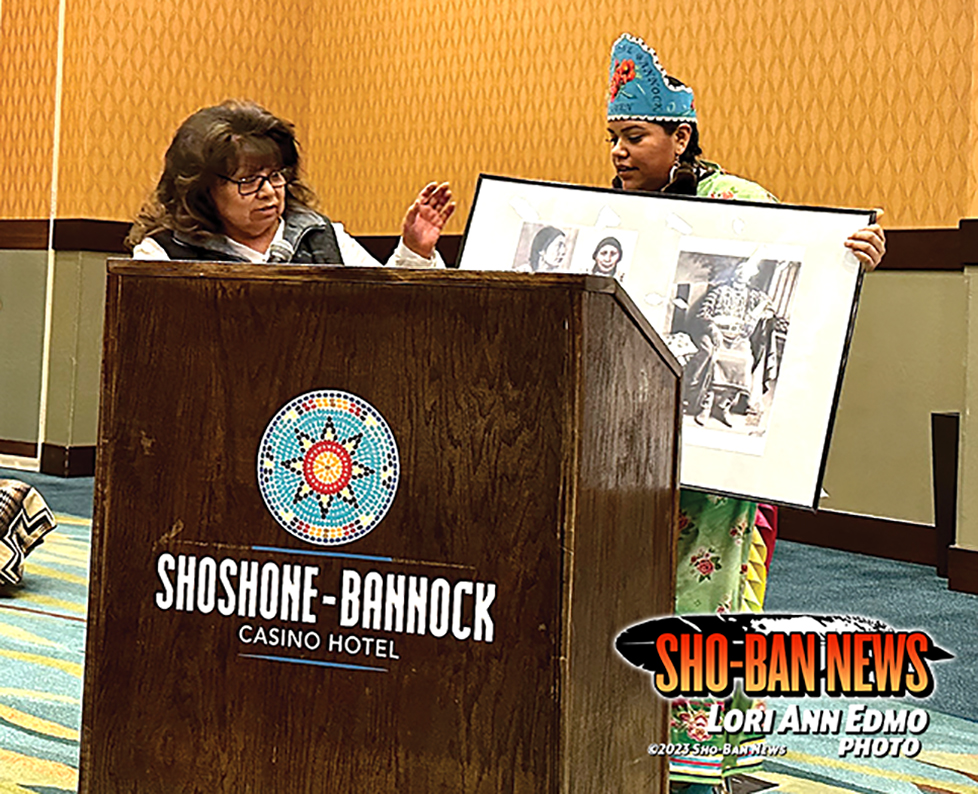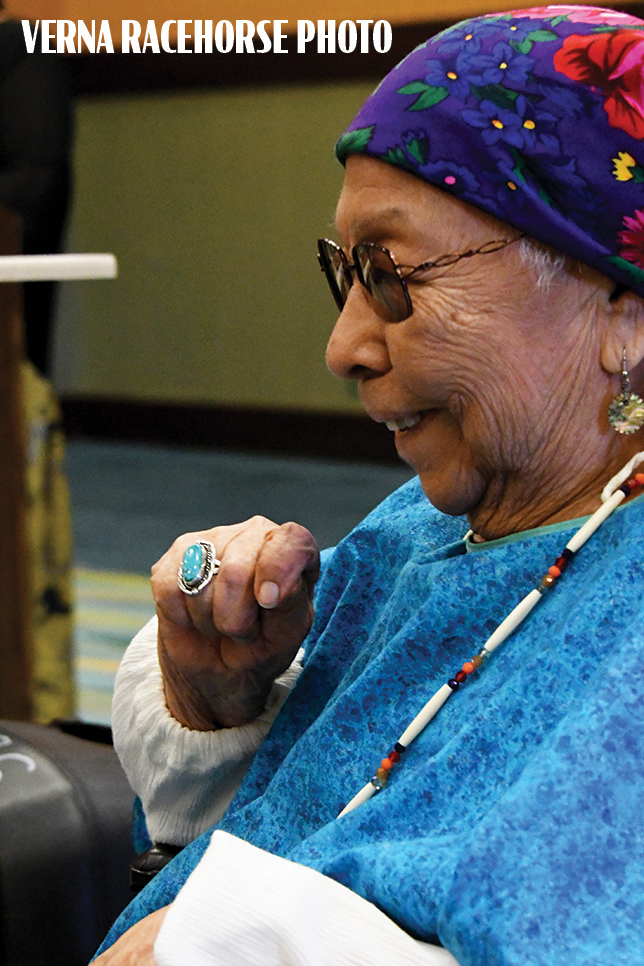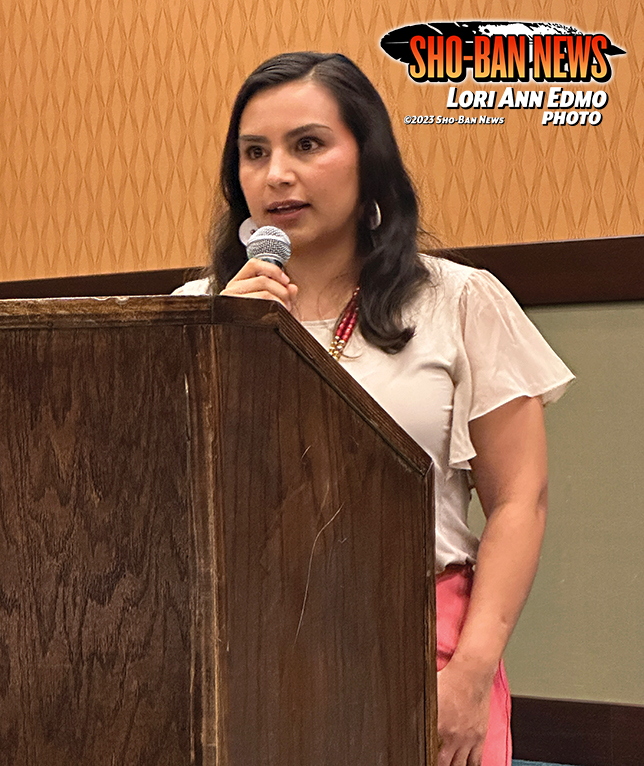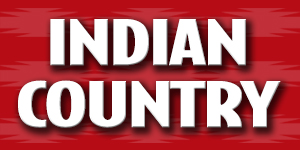Shoshone-Bannock women honored for Women's History Month

Miss Shoshone-Bannock Kaycee Dixey presents photos of Sarah Pokibro Snipe and Peahbah Diggie to Audrey Jim at the Appreciate Shoshone-Bannock Women event on Saturday, March 18.
By LORI ANN EDMO
Sho-Ban News
FORT HALL — It was a day to honor Shoshone-Bannock women March 18, since March is Women’s History Month.
The Shoshone-Bannock Tribes Language and Culture Preservation Department, along with the Victims Assistance Program (VAP) and Sho-Ban News hosted the event at the Shoshone-Bannock Hotel Events Center to honor the Tribes language, teachings and to showcase the dresses worn by momokoni and wai’ipenee (women).
The funds to pay for the event was done through fundraising so could only afford to pay for 200 lunches but as it turned out, there was enough for everyone, said Louise Dixey, LCPD Director.
The day began with a Bannock prayer from tribal elder Zelphia Towersap, followed by an honor song and flag song from Nelson Racehorse and Burdette Osborne. Fort Hall Business Council chairperson Donna Thompson gave a welcome, along with Miss Shoshone-Bannock Kaycee Dixey. VAP manager Audrey Jim also welcomed attendees and was presented framed posters of the women featured on them – Sarah Pokibro Snipe and Peahbah Diggie.
Velda Racehorse provided information on Snipe and Diggie. She explained Sarah was born to Ashee and Pooyah Pokibro in 1896 east of the present site of Fort Hall. Her brothers were Russell and John Pokibro. She was educated at the Fort Hall Boarding School. She married Tsegetiveo in 1915 and they had a daughter Irene Preacher and a son Raymond Testivo. After she divorced Tsegetivo, Sarah married Johnnie Snipe. In 1939 she was elected to the Fort Hall Business Council representing the Ross Fork District. She spoke English and the Bannock language. Sarah’s grandchildren are Janice Satanus, Delbert Farmer, Evelyn Wheeler and Willie Preacher (all deceased), along with Lloyd Preacher.

Tribal elder Louida Ingawanup enjoys the event.
Peahbah Having Hooves Diggie was born in 1871 and died in 1942. Her mother was Tazeno and father To-sah-kah-geh-u (Bannock language) meaning Having Hooves. Her Indian name and given name meant Big Water. She married Charley Diggie and they had 13 children with seven surviving and they resided in Gibson off Diggie Road. Her granddaughter Maxine Edmo remembered Peahbah tanning hides and sewing mostly buckskin gloves. She always wore moccasins and her feet were callused. Peahbah only lived a year after Charley passed. All the articles she made were buried with her such as Indian saddles.
Keynote address
Jessica Matsaw gave the keynote address that was a love letter to the women in her life. She introduced herself then explained her parents, grandparents, her children, along with her husband of 13 years Sammy Matsaw Jr. She is finishing her PhD focusing on Indian education reform and land pedagogy. She taught at Sho-Ban High School for three years and is currently teaching online high school/college courses through the University of Idaho.
Jessica is a mother, student, survivor of domestic abuse, a daughter, wife, a granddaughter. “I decided the best way to talk about who I am is to acknowledge the women important to me. And so, I decided to write a love letter to the women in my life,” she said.
She explained when she began healing she turned to the earth, “our beautiful Sogope bia.” Much of her learning to be a good wiapa was through Mother Earth – how to gather medicine, food, and materials to weave and create. How to gather mint, buffalo grass, saip for ceremony and our people. “I have learned in order to take care of ourselves we must also take care of the land, water, and the air we breathe.”

Keynote speaker Jessica Matsaw.
She explained she always had a special place in her heart for her grandmothers, “women who have shown me little and big things like how to bathe my babies, care for them and call on our inner strength when needed. When I brought my daughters into the world, I also called for my grandmothers’ spirit to be with me.” “This love letter is to my grandmothers, those who have played an important part in raising me and those who I have only met in spirit. I learned many years ago that grandmother, mothers, and daughters hold a sacred bond. When a mother is pregnant with a daughter, they are also carrying their grandchildren inside them.”
To the mothers in her life she recalled her bia Lorrie, “as a child I remember looking at your hands when we would sew together. As I became a mother to my first son, you taught me how to sew a cover for his baby board. Later, with my first daughter, my baha Tula showed me how to weave together a willow board.”
“To my aunty mommas who have taken care of me and shown me how to build my circle with prayer and dance, I will forever love you. My aunty momma Shirley, you have taught me how to pray and carry myself down to the water. Bless myself and heal.”
Concerning her sisters, “One of the greatest gifts is watching my sisters be a baha to my children. To know that they care for them as if they are their own. This is our way as Shoshone- Bannocks and a right given to you by creator.”
“My sister Alex, I have not known laughter the way I know it with you. To laugh so hard, so loud, until our bellies hurt and tears are rolling down our cheeks,” she said.
“To my sister Heather, I have learned to be my sisters keeper as we have promised to protect each other as little girls. When you were little and became very sick, you became my sister with special needs. I have learned from you that everyone has a gift, and that disabilities do not define a person. Some of my favorite memories has been coaching you in special Olympics, listening to you sing and watching you be a baha in your own special way.”
Concerning her daughters, she said they are her biggest teachers to learn the language, how to be strong and to fight for their future as they’ve taken care of her spirit. Her greatest prayer is they live a long life together, healthy and happy. Her greatest joy is to be their bia (mother).
She explained she’s survived a lot and experienced domestic abuse. She’s learned to understand what a healthy relationship should look like and know the fear of almost losing her life. “I have had to learn to poor into myself as we cannot love others if we do not love ourselves. It has been through ceremony that I have been able to cry, care for and grieve. It is through motherhood that I was able to fight and stand up for myself and my children. I share this because there are many women, young and old who have gone through hard things. I stand here to say you are worth love and respect. You are strong and I am proud of all the adversity you have gone through.”
To the women in the room she said many have guided her, given advice when she most needed it or are strong examples of what it means to be a Shoshone-Bannock waiapa. “We have laughed together and grieved together. I am forever grateful to you. I hope to carry myself in a good way to also pour into the next generation of women,” she continued. “On the difficult days I pray to creator we remember to uplift each other. To remember to be kind to one another. We are the nation builders, the ones who carry the sacred water in our bellies, the healers, and the nurturers,” Matsaw concluded, this is the love letter to the women in my life.
Workshops
The morning activities continued with three different workshops – basket weaving with instructors Bobette Haskett and Sonya Wadsworth; beading with Maliah Tindore and family trees in the Bannock and Shoshone language with Manuelita Waterhouse.
Haskett and Wadsworth taught how to make a small basket through twining. They had about 30 participants with some completing by the end of the day. They gave a handout that gave specific instructions on how to do it.
Maliah Tindore gave out small packets from Indigenous Supplies to create a pair of earrings. Many were fully concentrated around the tables focusing on their work.
In another corner, Waterhouse gave handouts for participants to complete their family trees in Bannock and Shoshone explaining the terms.

Sonya Wadsworth demonstrates weaving.
At lunch essay winners were recognized and each given $50 prizes from Louise E. Dixey. Mountain View Middle School student Susan Dixey Avila has three strong women in her life – first her zozo Maxine Racehorse Edmo, second her cugoo Louise Edmo Dixey and third is her bea Lee Ann Dixey Avila. She wrote about the struggles in her life and encouraged others to learn where the come from. Dominque Broncho, a Highland High School freshman, said the three important women in her life are her mother Deena Kniffin-Broncho as she’s a hard worker, her grandmother Theresa Bache whose taught her to be proud of her culture and her other grandmother Marilyn Broncho who is a hard worker and a fluent language speaker. Sunshine Perry wrote about her sister Georgette Running Eagle who is the one constant woman in her life. She’s provided a safe space for her and showed her what it means to be a homemaker, crafter, beader, sewer and a traditional woman. Sunshine is forever thankful for the impact Georgette has on her life. “I hope to always follow in her footsteps and become even a fraction of the woman she is.”
Honoring elder women
Thanks to donations of a shawl, Pendleton blankets and necklaces, the five eldest women in each Fort Hall Reservation district were honored. The oldest living Shoshone-Bannock woman is Ramona Whitworth and although she wasn’t present, her granddaughter Bailey Dann delivered the gray embroidered shawl to her after the event. Louise Dixey and Jon Timbana donated the shawl and Anna Bowers did the embroidery on the back. Jennifer Christy was recognized from the Bannock Creek District and received a Pendleton blanket also donated by FHBC member Claudia Washakie. Washakie also donated necklaces that were presented to all the elders recognized. Bernita Teton was honored from the Lincoln Creek District and her brother Larry Teton donated it. Colleen Edmo received a Pendleton blanket from the Maxine Edmo collection. FHBC Vice Chairperson Donna Thompson presented the Fort Hall District Pendleton blanket to Venus Cortez and her daughter Yvonne Cortez picked it up. Gibson District honoree is Ernestine Werelus and her blanket was donated by Louise Dixey.
The Traditional clothing show followed with 37 participants. (see related story).
Dixey said the Traditional teachings panel was worth the wait. RoseAnn Abrahamson, Vivian Wahtomy and Velda Racehorse all talked about their life experiences.
Overall the day was very heartwarming and positive Dixey said. “I am proud to see so many who are willing to honor our Shoshone Bannock women and support one another. The number of ladies that took part in the Clothing show was very inspiring — we have so many talented beadworkers and seamstresses that create dresses for all purposes, work dresses, wing dresses, shell and elk tooth dresses and beautiful buckskin dresses is amazing,” she continued. “I’m proud to be a Shoshone-Bannock mogoni (woman).”





